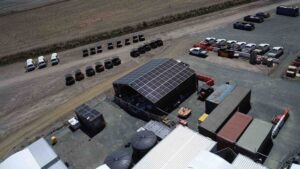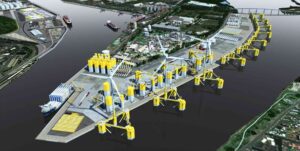A world first offshore wind “energy island” is one step closer to being realised, after a Belgian consortium known as TM Edison was tapped to build the ground-breaking project.
Anchored in the grey, silty North Sea, the artificial Princess Elisabeth Island is being developed by Elia Group to received the glut of power from a new 3.5GW offshore wind farm and convert it to high voltage electricity to be transmitted to the Belgian mainland and other European countries via a series of new transmission lines.
The island received a €100 million subsidy from the Belgian government under the EU’s European Covid Recovery and Resilience Plan.
The sprawling concrete complex will be the world’s first artificial energy island that combines both direct current (HVDC) and alternating current (HVAC).
The island sit around 45km off the coast of Belgium and will cover about six hectares, or twelve football fields. It will be made primarily of concrete caissons filled with sand, and will feature a small harbour and helicopter platform to allow maintenance crews to visit.
The island’s high-voltage infrastructure will bundle the wind farm export cables together while also acting as a hub for future interconnectors with the UK (Nautilus) and Denmark (TritonLink). That makes Princess Elisabeth Island the foundation stone for what will one day be an integrated European offshore energy grid.
“This project is a pioneering one for several reasons,” says Elia Group CEO Chris Peeters.
“It is the most cost-effective and reliable way to bring offshore wind to shore. It will be an island that provides options for the future. When we connect it to other countries, the Princess Elisabeth Island will become the first offshore energy hub.”
Belgium’s federal minister of energy, Tinne Van der Straeten, says the move solidifies Belgium’s status as a pioneer in offshore wind power.
“Our offshore expertise is now recognised worldwide,” said Van der Straeten.
“By continuing to innovate, we are also strengthening our position for the future. We are giving our Belgian companies another chance to be true pioneers, both here and abroad.”
The North Sea, a thin finger of shallow water that separates the east coast of England and Scotland from mainland Europe, has been an energy hub since the earliest discoveries of oil and gas off the coasts of the UK, the Netherlands and Germany in the 19th Century.
Vincent Van Quickenborne, Belgium’s federal minister of justice and the North Sea, said the body of water now had an important role to play in the world’s next great energy transition.
“The North Sea will become the engine of our energy independence,” he said. “The Princess Elisabeth Island will be an essential link in this.
“Our country has long been a pioneer in the field of offshore wind power with companies such as DEME and Jan De Nul, which are world leaders.
“They are proving it once again with these plans for the world’s first energy island. It is thanks to their expertise and their role as global pioneers that we can accelerate the energy transition together,” Van Quickenborne said.
TM Edison is composed of DEME Group and Jan De Nul Group, and was selected based on the consortium’s specialised fleet the companies’ combined expertise in dredging, land extension, coastal protection and civil engineering.
Construction on the island will begin in early 2024 and is expected to conclude in August 2026. Elia hopes that all of Belgium’s wind farms will be fully connected to the mainland by 2030.










